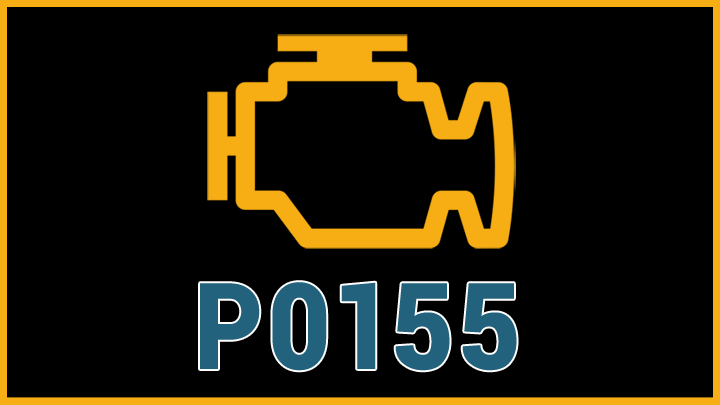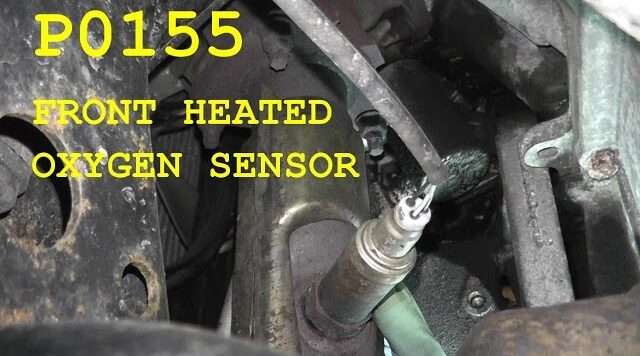
P0155 Oxygen Sensor Heater Circuit Malfunction (Sensor 1, Bank 2)
Content
P0155 – OBD-II Trouble Code Technical Description
Trouble code P0155 indicates a malfunction in the oxygen sensor heater circuit (sensor 1, bank 2).
What does the fault code mean P0155?
Trouble code P0155 indicates a problem with the Oxygen Sensor on circuit 1, bank 2. This means that the engine control module (ECM) has detected an incorrect voltage or signal from the oxygen sensor in cylinder bank 2 (bank XNUMX). When this error occurs, the Check Engine light on the vehicle's dashboard will light up, indicating a malfunction.

Possible reasons
Possible causes for DTC P0155 include:
- Defective oxygen sensor: The oxygen sensor itself may be damaged or failed, resulting in an incorrect reading of the oxygen content of the exhaust gases.
- Damaged wiring or connectors: Opens, corrosion, or poor connections in the wiring or connectors connecting the oxygen sensor to the engine control module (ECM) can cause the P0155 code.
- Problems with power or grounding of the oxygen sensor: Improper power or grounding of the oxygen sensor can cause undervoltage or overvoltage on the signal circuit, causing trouble code P0155.
- Malfunctions in the engine control module (ECM): Problems with the engine control module, which processes signals from the oxygen sensor, can also cause P0155.
- Problems with the catalyst: Catalyst failures can cause the oxygen sensor to malfunction, which can cause P0155.
- Incorrect installation of the oxygen sensor: Improper installation of the oxygen sensor, such as too close to a hot source such as the exhaust system, can cause a P0155 code.
Troubleshooting a P0155 code typically involves diagnostics to determine the specific cause and then appropriate repairs or replacement of the faulty components.
What are the symptoms of a fault code? P0155
Symptoms for DTC P0155 may include the following:
- Errors on the dashboard (Check Engine Light): One of the most common symptoms is the Check Engine Light (CEL) coming on on your dashboard. This is the first sign that drivers may notice.
- Unsteady or rough idle: Problems with the oxygen sensor can cause the engine to idle rough, especially when running on a cold engine.
- Loss of power on acceleration: A faulty oxygen sensor may result in loss of power when accelerating or require higher engine speeds to achieve the desired speed.
- Increased fuel consumption: Improper operation of the oxygen sensor can result in increased fuel consumption due to suboptimal operation of the engine management system.
- Engine instability: Other symptoms may include rough running of the engine, including shaking, rough running and irregular idle speed.
- Poor vehicle performance: General vehicle performance problems may occur, including weaker acceleration and poor response to throttle control commands.
If you experience these symptoms, especially when the Check Engine Light is on, it is recommended that you take it to a qualified mechanic to diagnose and repair the problem.
How to diagnose a fault code P0155?
Possible symptoms for DTC P0155:
- Errors on the dashboard (Check Engine Light): One of the most common symptoms is the Check Engine Light (CEL) coming on on your dashboard. This is the first sign that drivers may notice.
- Unsteady or rough idle: Problems with the oxygen sensor can cause the engine to idle rough, especially when running on a cold engine.
- Loss of power on acceleration: A faulty oxygen sensor may result in loss of power when accelerating or require higher engine speeds to achieve the desired speed.
- Increased fuel consumption: Improper operation of the oxygen sensor can result in increased fuel consumption due to suboptimal operation of the engine management system.
- Engine instability: Other symptoms may include rough running of the engine, including shaking, rough running and irregular idle speed.
- Poor vehicle performance: General vehicle performance problems may occur, including weaker acceleration and poor response to throttle control commands.
If you experience these symptoms, especially when the Check Engine Light is on, it is recommended that you take it to a qualified mechanic to diagnose and repair the problem.
Diagnostic errors
When diagnosing DTC P0155, the following errors may occur:
- Incorrect interpretation of oxygen sensor data: One common mistake is misunderstanding the data received from the oxygen sensor. This can lead to misdiagnosis and replacement of components that are not actually causing the problem.
- Incorrect checking of wiring and connectors: Improper handling of wiring and connectors, such as accidentally disconnecting or damaging wires, can cause additional problems and create new errors.
- Ignoring other potential causes: Focusing only on the oxygen sensor without considering other possible causes of the P0155 code, such as problems with the exhaust system or fuel injection system, can lead to important details being missed.
- Poor decision to repair or replace components: Making the wrong decision to repair or replace components without sufficient diagnosis and analysis can result in additional repair costs and ineffective resolution of the problem.
- Failed diagnostic tests: Improperly performed diagnostic tests or the use of inappropriate equipment can lead to unreliable results and incorrect conclusions about the causes of the P0155 code.
To avoid these mistakes, it is important to follow professional diagnostic techniques, use the correct equipment, perform tests in accordance with the manufacturer's recommendations and, if necessary, contact an experienced technician for help and advice.
How serious is the fault code? P0155?
Trouble code P0155, indicating a problem with the Oxygen Sensor on circuit 1, bank 2, should be considered a serious problem that requires attention and diagnosis. Here are a few reasons why this code is serious:
- Impact on engine efficiency: A faulty oxygen sensor can cause an incorrect reading of the oxygen content in the exhaust gases, which can result in an inefficient fuel/air mixture. This, in turn, can lead to loss of power, poor fuel economy, and other engine performance problems.
- Impact on environmental performance: Insufficient oxygen in exhaust gases can lead to increased emissions of harmful substances into the atmosphere, which can negatively impact the environment and attract the attention of regulatory authorities.
- Increased fuel consumption: A faulty oxygen sensor can cause the engine management system to make incorrect adjustments, which can ultimately lead to increased fuel consumption.
- Potential catalyst damage: Incorrect operation of the oxygen sensor can negatively affect the performance of the catalytic converter, which can ultimately cause it to become damaged and require replacement, which is a serious and costly problem.
- Loss of vehicle control: In some cases, a faulty oxygen sensor can cause the engine to run rough, which can affect the vehicle's handling, especially in critical situations.
Considering all these factors, it is recommended that you contact a professional to diagnose and resolve the problem when the P0155 trouble code appears.
What repair will help eliminate the code? P0155?
Troubleshooting trouble code P0155 may include the following steps:
- Replacing the oxygen sensor: The most common cause of the P0155 code is a malfunction of the oxygen sensor itself. In this case, replacing the sensor with a new, working unit will help eliminate the problem.
- Checking and replacing wiring and connectors: Check the condition of the wiring and connectors connecting the oxygen sensor to the engine control module. Poor connections, corrosion or breaks can cause P0155. If necessary, replace damaged wires or connectors.
- Checking power and grounding: Make sure the oxygen sensor is receiving proper power and ground. Check the voltage on the corresponding contacts.
- Diagnostics of the catalyst: Catalyst failures can cause the oxygen sensor to malfunction, which can cause P0155. Check the condition of the catalyst and, if necessary, replace it.
- Engine Control Module (ECM) Diagnosis: In rare cases, the problem may be due to a faulty engine control module. This may require diagnosis and, if necessary, repair or replacement of the ECM.
- Updating the software: Sometimes the problem can be solved by updating the engine control module software.
The specific repair chosen will depend on the cause of the P0155 code, which must be determined during the diagnostic process. If you are unsure of your skills or experience, it is recommended that you have your vehicle diagnosed and repaired by a qualified mechanic or authorized service center.
P0155 – Brand-specific information
Deciphering the P0155 trouble code for some specific car brands:
- Volkswagen (VW): P0155 – “Oxygen Sensor Heater Circuit Malfunction (Bank 2 Sensor 1)”.
- Ford: P0155 – “Oxygen Sensor Heater Circuit Malfunction (Bank 2 Sensor 1)”.
- Chevrolet / GMC: P0155 – “Oxygen Sensor Heater Circuit Malfunction (Bank 2 Sensor 1)”.
- Toyota: P0155 – “Oxygen Sensor Heater Circuit Malfunction (Bank 2 Sensor 1)”.
- BMW: P0155 – “Oxygen Sensor Heater Circuit Malfunction (Bank 2 Sensor 1)”.
- Mercedes-Benz: P0155 – “Oxygen Sensor Heater Circuit Malfunction (Bank 2 Sensor 1)”.
- Audi: P0155 – “Oxygen Sensor Heater Circuit Malfunction (Bank 2 Sensor 1)”.
- Honda: P0155 – “Oxygen Sensor Heater Circuit Malfunction (Bank 2 Sensor 1)”.
- Hyundai: P0155 – “Oxygen Sensor Heater Circuit Malfunction (Bank 2 Sensor 1)”.
- Nissan: P0155 – “Oxygen Sensor Heater Circuit Malfunction (Bank 2 Sensor 1)”.
This is a general explanation for the specified error code. It is recommended to clarify the information for the specific model of your car for a more accurate understanding of the situation.
